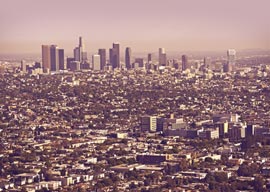
February 18, 2015

Los Angeles
Source: Shutterstock
Leovy notes that less than five percent of the murders of black men in South Central directly involved drug deals. This doesn”t mean that the profits from drug dealing don”t have some impact on how enthusiastically blacks team up in gangs and shoot each other, as we saw during the crack wars around 1990 or the powder cocaine wars that peaked in 1980.
But much of the killing reflects knuckleheads being knuckleheads in a shoot-first environment. Murder is a way of life in these Hobbesian black slums, which remind Leovy of lawless tribes in the accounts of anthropologists. In Los Angeles:
The smallest ghettoside spat seemed to escalate to violence, as if absent law, people were left with no other means of bringing a dispute to a close. Debts and competition over goods and women”especially women”drove many killings. But insults, snitching, drunken antics, and the classic”unwanted party guests”also were common homicide motives. Small conflicts divided people into hostile camps and triggered lasting feuds. Every grudge seemed to harbor explosive potential. It would ignite when antagonists met by chance, gunfire erupting in streets or liquor stores.
(The blog Handle’s Haus recently put forward the alarming hypothesis that keeping drugs illegal is less the cause of black predation than a cynical cure for it, by giving idle hands a small business”dealing drugs”to do on their home turf in South Central rather than engaging in, say, home invasions in Brentwood.)
Why are blacks in Los Angeles so much worse behaved than whites and Asians, or even Hispanics? (Keep in mind that L.A. traditionally has the most vicious Mexican and Central American gangs in the country.) Leovy recounts cops
… trying to figure out how to accommodate their experiences at work with the antiracism they shared with most of their countrymen. … No one in the wider world seemed to want to talk about it, but black residents, to many officers, appeared more violent than Hispanics. Their own eyes told them so. Statistics backed them up. Few officers wanted to believe that black people were somehow intrinsically wired for violence.
Leovy offers a complicated theory about how blacks were ruined by the poor criminal justice system in the post-Civil War South. But was policing in the American South in 1915 really three times worse than in Mexico, during the Mexican Revolution that killed some one or two million people?
And, anyway, it’s now the 21st century.
A more plausible explanation for why Los Angeles” gang violence became famous around the world via the entertainment industry would be that the entertainment industry, which celebrates African-Americans” worst instincts, is centered in Los Angeles.
If you are looking for a white man to blame for blacks behaving badly, how about starting with music executive Jimmy Iovine (net worth $970 million)? Back in 1988 Iovine managed the initial gangsta rap album, N.W.A.’s Straight Outta Compton, which did much to glamorize crack dealing among impressionable black youths with low IQs. (Iovine recently bought a $60 million Malibu mansion, so go gentle on him.)
Nor is it particularly encouraging for the future of America that black male behavior deteriorated so spectacularly where blacks first came into massive contact with Latin American illegal immigrants, who proved much more satisfactory to employers, thus rendering unskilled black males irrelevant as workers.
Finally, one may ask: How much of black knuckleheadedness in South Central Los Angeles”with its superb climate and freeway-close location”is a rational political response to the long-term threat of gentrification?
On July 4, 1977, I drove down to look at the site of the Watts riots and was amazed by how nice the residential streets were. Leovy likewise muses:
Yet for all its notoriety, the landscape of Watts was not as formidable as its reputation. This was not a no-man’s land of high-rise slums. Trees and lawns adorned tiny detached one-story houses … And, of course, Watts claimed an equal share of the city’s best attributes. It was Mediterranean and golden, with air that was soft in summer and crisp in winter. Gardens there burst with bird-of-paradise flowers and purple-blooming jacarandas.
Blacks are being slowly pushed out of potentially valuable places like Watts by Latin American immigrants, sometimes economically, sometimes violently. But poor Mexicans and Salvadorans aren”t particularly formidable competitors compared to, say, Koreans, Armenians, Persians, Israelis, Russians, and other nationalities flooding into less violent parts of the Southland.
There are a lot of people in this world who grew up dreaming of moving to greater Hollywood, and many of them are more cunning and effectual at realizing their dreams than typical Latinos. The chaos of black crime, however, makes them think twice about trying to push African-Americans out of the mellow Los Angeles basin.
My guess is that about 2070, African-Americans will think back in astonishment at the amazing places where their ancestors had once lived”the heart of Los Angeles; Manhattan, San Francisco and Oakland; the Chicago lakefront; the nation’s capital”and wonder how they let it all slip away.